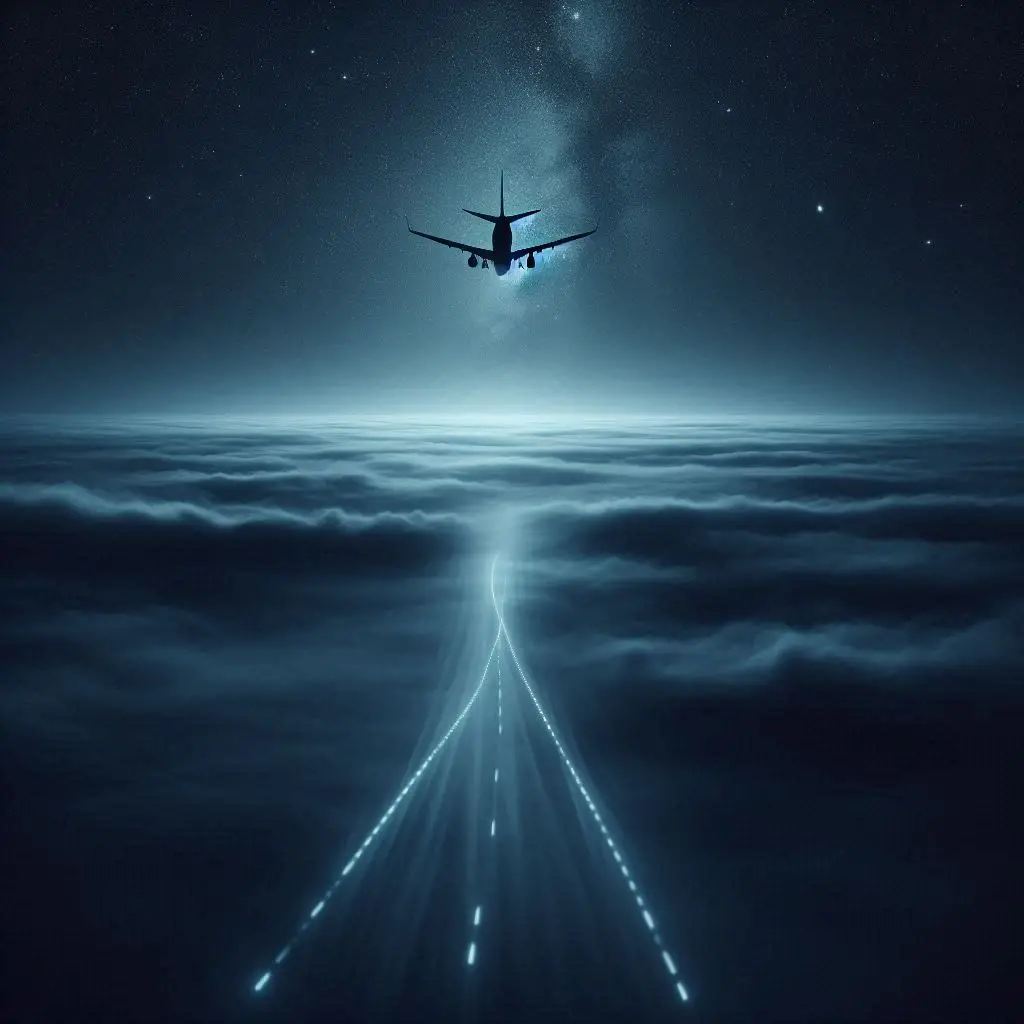It was a warm night over the South China Sea. The lights of Kuala Lumpur twinkled far below as passengers boarded Malaysia Airlines Flight 370—227 travelers and 12 crew, headed for Beijing. Families waved goodbye, babies cried softly, and the Boeing 777 began to roll down the runway, its engines roaring to life.
At 12:42 a.m. on March 8, 2014, Flight 370 lifted off into the dark. Everything about it seemed ordinary. Within six hours, those on board should have been landing in China, watching the sunrise out the window. But they never arrived.
Somewhere between Malaysia and Vietnam, the plane simply vanished. No distress call. No radar signal. Just silence.
And what followed would become one of the greatest aviation mysteries of all time—a story of confusion, secrets, and unanswered questions. This is the haunting tale of the ghost plane.
The Flight
Flight 370 was piloted by Captain Zaharie Ahmad Shah, a veteran with over 18,000 flight hours, and his co-pilot Fariq Hamid, who was only 27. The aircraft, a Boeing 777, was among the safest in the world—modern, reliable, and equipped with multiple backup systems.
At 1:07 a.m., the last routine message was sent from the plane’s communication system. Eleven minutes later, as the plane crossed from Malaysian into Vietnamese airspace, air-traffic control radioed the crew.
“Good night, Malaysian Three Seven Zero,” the controller said.
“Good night, Malaysian Three Seven Zero,” Captain Zaharie replied.
Those were the last words ever heard from the flight.
Two minutes later, at 1:21 a.m., the plane’s transponder—the device that tells radar who you are and where you are—was turned off.
And in that moment, Flight 370 disappeared from the radar screen.
The Vanishing
When Vietnam didn’t receive contact, they tried repeatedly to reach the plane. No answer. Malaysian controllers did the same. Still nothing.
At first, officials assumed it was a technical issue. Planes sometimes lose radio contact briefly. But when Flight 370 missed its next scheduled check-in, the situation turned from strange to terrifying.
A search was launched along its expected path over the South China Sea. Dozens of ships and aircraft scanned the water. But there was no debris. No oil slick. No signal.
It was as if the massive aircraft—and everyone on board—had been erased from existence.
Then came the first shocking discovery.
The Turn
Five days later, military radar data revealed something no one expected. After the transponder was switched off, Flight 370 hadn’t crashed—it had turned around.
The 777 had made a sharp left turn, flying back across the Malaysian Peninsula, then northwest toward the Indian Ocean. For more than an hour, it continued to fly in silence.
Whoever was at the controls knew exactly what they were doing. The plane navigated along known airways, slipping between radar zones like a ghost.
But why?
If this was a hijacking, why hadn’t anyone claimed responsibility? If it was mechanical failure, why didn’t the pilots radio for help?
And if it was something else—something darker—what exactly had happened inside that cockpit?
The Satellite Handshake
For weeks, investigators searched the South China Sea, convinced that’s where the plane had gone down. They found nothing.
Then engineers at a British company called Inmarsat made a startling realization.
Even though the plane’s communications were turned off, its satellite antenna still sent tiny automatic “handshakes” to a satellite every hour—a kind of digital heartbeat.
By analyzing those faint signals, investigators discovered that Flight 370 had continued flying for nearly seven more hours after disappearing from radar.
The handshakes showed two possible paths:
-
One north, over Asia.
-
One south, over the Indian Ocean.
Given that no radar had picked up a plane flying north, the evidence pointed to the southern route—a remote expanse of ocean west of Australia, one of the most isolated regions on Earth.
That’s where Flight 370 is believed to have gone down.
But why did it fly there? And who was flying it?
The Suspects
Every mystery needs suspects, and soon the world turned its attention to the cockpit.
Investigators looked closely at Captain Zaharie Ahmad Shah. He was respected and experienced, but his life wasn’t simple. He was separated from his wife and reportedly struggling emotionally.
Forensic teams examined his home flight simulator and found something disturbing: a route eerily similar to the final flight path of MH370—a course that ended in the southern Indian Ocean.
Was this a coincidence, or a clue?
Some believed Zaharie had planned a murder-suicide. That he waited for the co-pilot to leave the cockpit, locked the door, turned off communications, depressurized the cabin to kill the passengers silently, and then flew alone until the fuel ran out.
It’s a chilling theory—but there’s no hard proof.
Others pointed to the co-pilot, Fariq Hamid, who was new to the 777 and on his first training flight without an instructor. Could he have made a mistake? Or was there something else at play?
Still others suspected hijacking—perhaps by passengers, or even a rogue crew member. But with no demands, no messages, and no trace, every explanation seemed incomplete.
The Search
The disappearance of Flight 370 triggered one of the largest search operations in history.
At first, searchers combed 50,000 square miles of ocean, guided by satellite data. When nothing turned up, they expanded it—covering an area larger than the size of the United Kingdom.
Ships equipped with sonar scanners mapped the seabed, searching for debris or the “pings” from the plane’s black boxes. The batteries for those pingers would last only about 30 days. They listened. Nothing.
Weeks turned into months. Months turned into years.
And then, finally—something surfaced.
The Debris
In July 2015, more than a year after the disappearance, a man walking along a beach on Réunion Island, thousands of miles from Malaysia, found a large piece of debris washed ashore.
It was part of a Boeing 777 wing—what’s called a flaperon. The serial numbers confirmed it: it came from Flight 370.
In the following months, more debris appeared on beaches in Mozambique, Madagascar, and Tanzania. Each piece matched MH370.
The ocean had finally given up clues—but not the answers.
Where was the rest of the plane?
And what had happened in those final hours before it vanished into the sea?
The Final Hours
Using the satellite data, experts pieced together a likely timeline.
At 1:21 a.m., the transponder was turned off.
At 1:30, the plane crossed back over the Malay Peninsula.
For the next several hours, it followed a path southwest across the Indian Ocean, slowly curving south.
At 8:19 a.m., seven hours after takeoff, the final handshake with the satellite was received—possibly a signal that the engines had flamed out from lack of fuel.
After that, silence.
Computer simulations suggest the plane entered a high-speed dive, plunging into the sea at more than 400 miles per hour. The impact would have shattered it into thousands of pieces—most of which likely sank instantly into deep water, more than two miles below the surface.
But one haunting question remains: why?
The Theories
The official investigation ruled the disappearance an “accident,” likely ending with the aircraft lost in the southern Indian Ocean. But that explanation satisfied no one.
Over the years, dozens of theories have emerged—some logical, others unbelievable.
One theory points to a fire in the cargo hold, perhaps from lithium batteries, forcing the pilots to turn back. But the plane’s controlled path contradicts a chaotic emergency.
Another theory says a sudden depressurization rendered everyone unconscious, leaving the plane to fly on autopilot until it ran out of fuel. But again—why the deliberate turns?
Then there are the darker theories.
Some believe the plane was hijacked by terrorists aiming for a 9/11-style attack, but failed and crashed. Others think the pilot deliberately crashed it in despair.
And the most extreme claim? That MH370 was taken by a foreign power, intercepted in mid-air, and hidden away for reasons no one understands.
Even the former Prime Minister of Malaysia hinted that something “beyond explanation” may have happened that night.
No theory fits all the evidence. And that’s what makes it terrifying.
The Families
For the families of the 239 people on board, the years that followed were unbearable.
In the early days, they gathered in hotels, clutching phones, waiting for news that never came. Some believed their loved ones were alive, held somewhere, waiting to be rescued. Others accepted the worst but couldn’t rest without proof.
Every time debris was found, hope surged—and then fell again.
One father told reporters, “I dream that my daughter will call and say she’s safe. Every day I wake up and realize she’s still gone.”
For them, the ocean is both a grave and a question mark.
The Ghost Flight
Perhaps the eeriest part of the story is what some pilots call “the ghost flight” theory.
In this version, the plane suffered a sudden depressurization at altitude. The passengers and crew fell unconscious within minutes. The autopilot, still running, kept the aircraft aloft for hours.
The “handshakes” with the satellite continued until the fuel finally ran out. The empty plane, full of sleeping passengers, drifted silently across the ocean until it spiraled down into the water.
It’s a chilling image—a 777 gliding through the darkness, its cabin frozen, its lights blinking faintly in the void, no one awake to see the sunrise.
The End of the Search
By 2018, after four years of searching, the official investigation was suspended. More than $160 million had been spent, covering over 120,000 square kilometers of ocean.
They found nothing more.
The final report concluded only this:
“The aircraft’s final resting place is unknown.”
But many investigators still believe the wreckage lies somewhere along the seventh arc—a long, curved line across the Indian Ocean where the final satellite pings were received.
Maybe, one day, technology will find it. Maybe not.
The Legacy of Flight 370
Flight 370 changed aviation forever.
New safety laws now require planes to transmit their locations more frequently. Satellites can track aircraft even over remote oceans. Families of missing passengers are promised faster, clearer communication in future tragedies.
But MH370 remains the ultimate unsolved mystery.
It reminds us that even in an age of constant connectivity—of satellites, smartphones, and global tracking—a 200-ton aircraft can still vanish without a trace.
And for those left behind, closure remains impossible.
One relative said, “It’s not the not knowing that kills you. It’s waking up every day and realizing you still don’t.”
The Ocean Keeps Its Secrets
The Indian Ocean is vast—deep enough to hide entire mountain ranges, dark enough to swallow anything. Somewhere beneath those waves, Flight 370 waits, its metal slowly corroding, its answers locked away forever.
What happened on that flight? Was it an accident, a crime, or something stranger?
We may never know.
But as long as the sea is silent, and the black boxes remain buried, the mystery of Malaysia Airlines Flight 370 will drift on—like the ghost plane it became.




